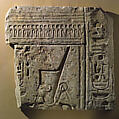Jubilee Relief of Ramesses II
New Kingdom, Ramesside
This deeply carved relief of Ramesses II shows the king wearing the red crown of Lower Egypt and seated within a shrine, the roof of which is decorated with uraei. It was part of a scene showing the king celebrating one of the sed festivals, or jubilees, of his long reign. Ramesses II, known as Ramesses the Great, ruled for sixty-six years and had an enormous impact both in Egypt and abroad. In his military campaigns, he confronted the expanding empire of the Hittites and eventually secured a treaty with them and married two Hittite princesses. He extended his rule far into Nubia, as the building of his huge rock-cut temple at Abu Simbel testifies. He built monuments as far north as Byblos in modern-day Lebanon and as far south as Jebel Barkal in the Sudan. He established a new capital at Piramesse in the eastern Delta.
This relief was found by Flinders Petrie in a temple that Ramesses II built at Heracleopolis, in the northern part of Egypt near the Faiyum and dedicated to the local god Harsaphes.
Due to rights restrictions, this image cannot be enlarged, viewed at full screen, or downloaded.
This artwork is meant to be viewed from right to left. Scroll left to view more.



